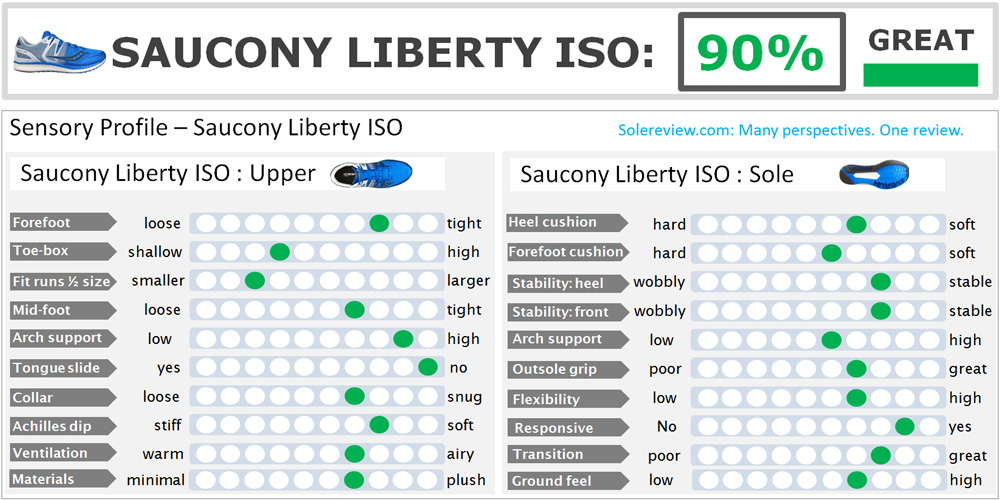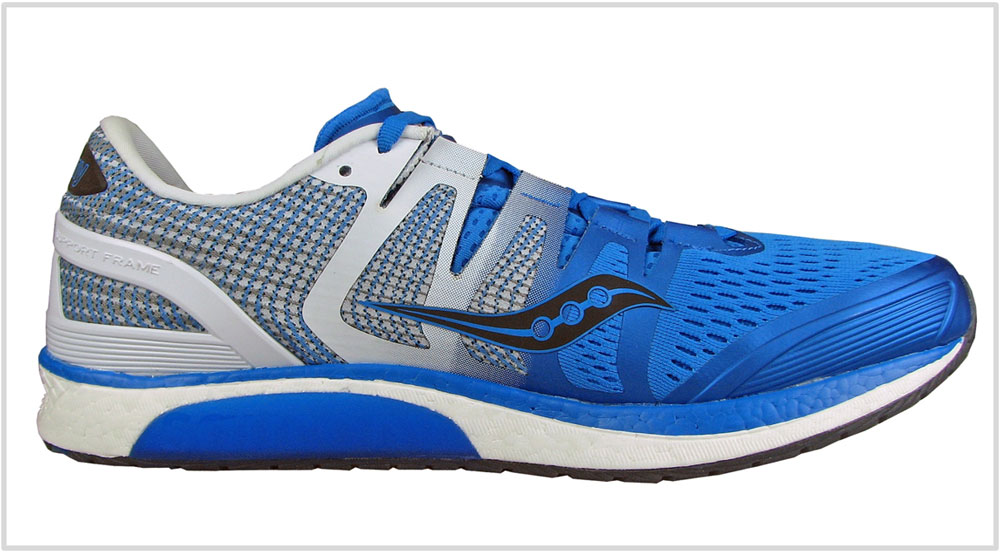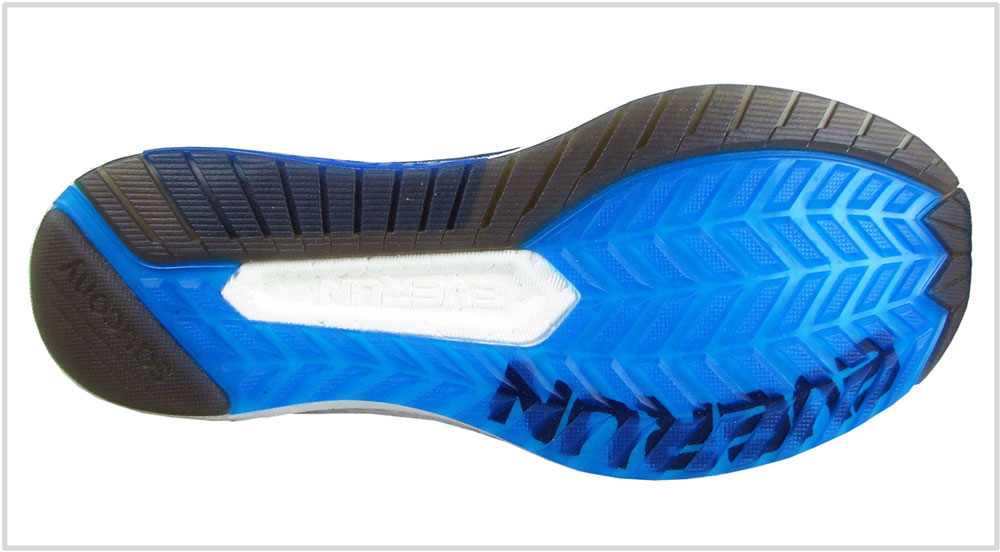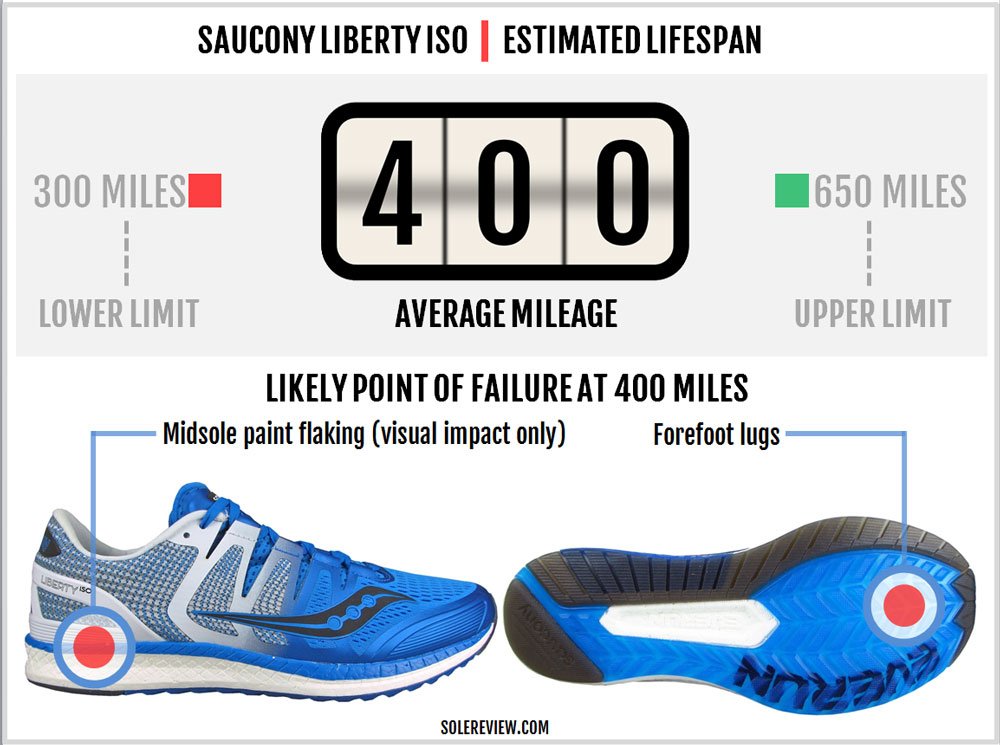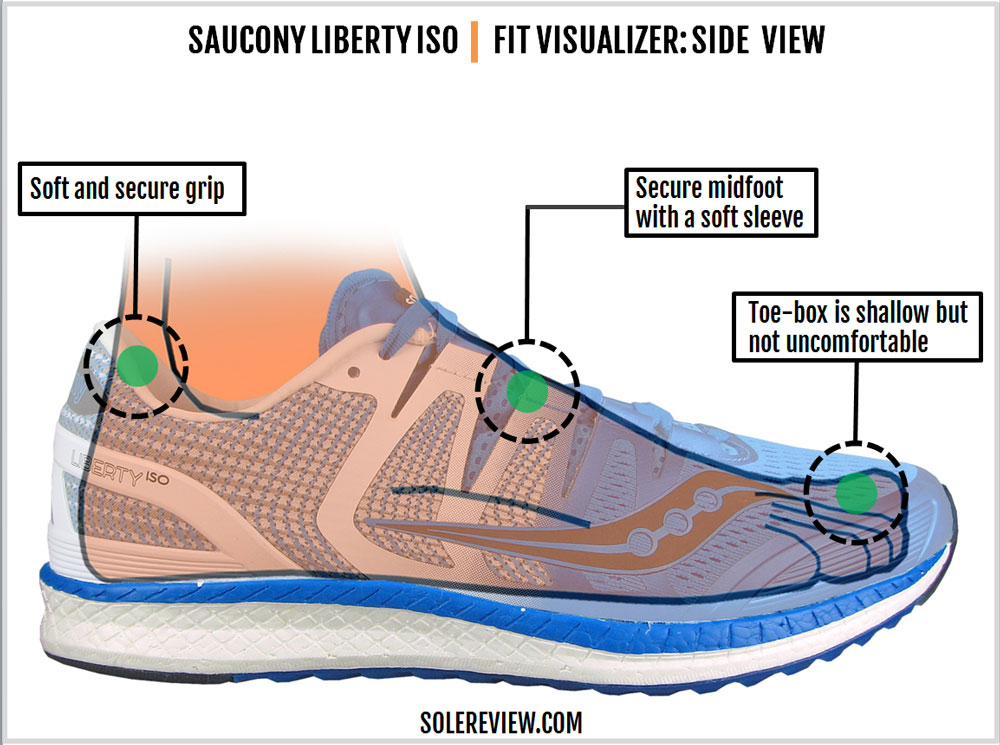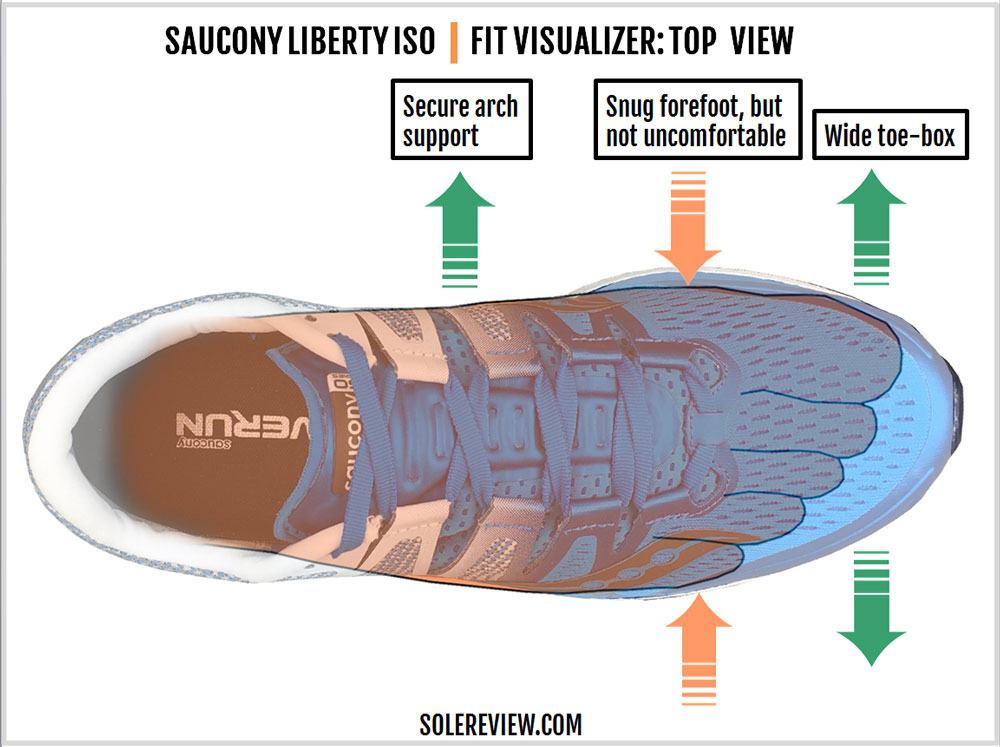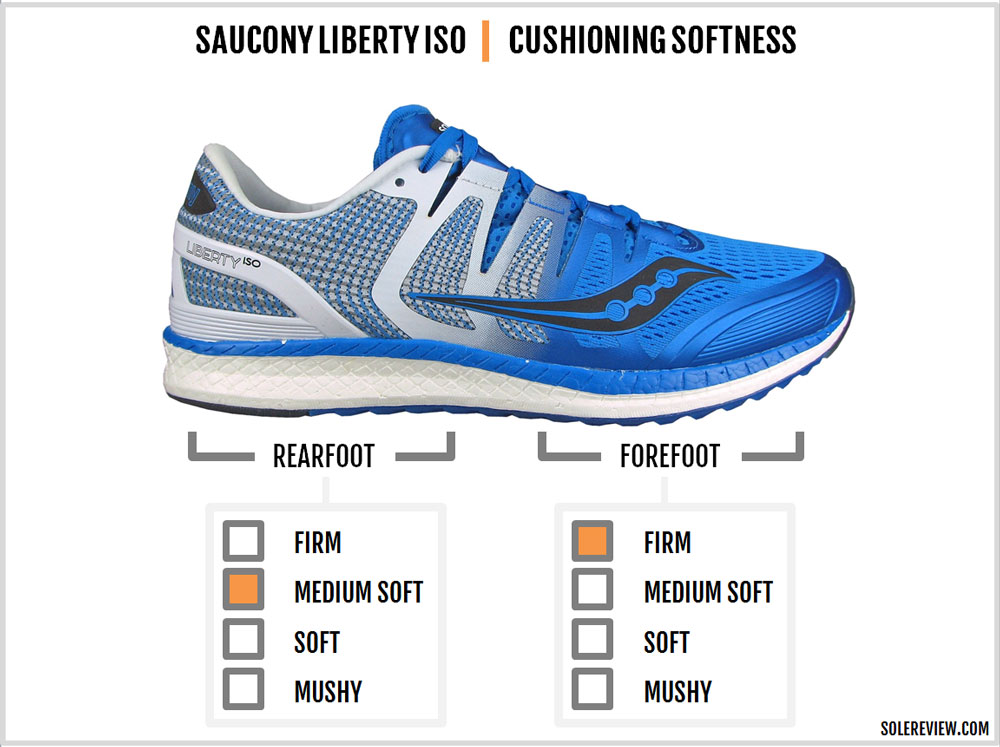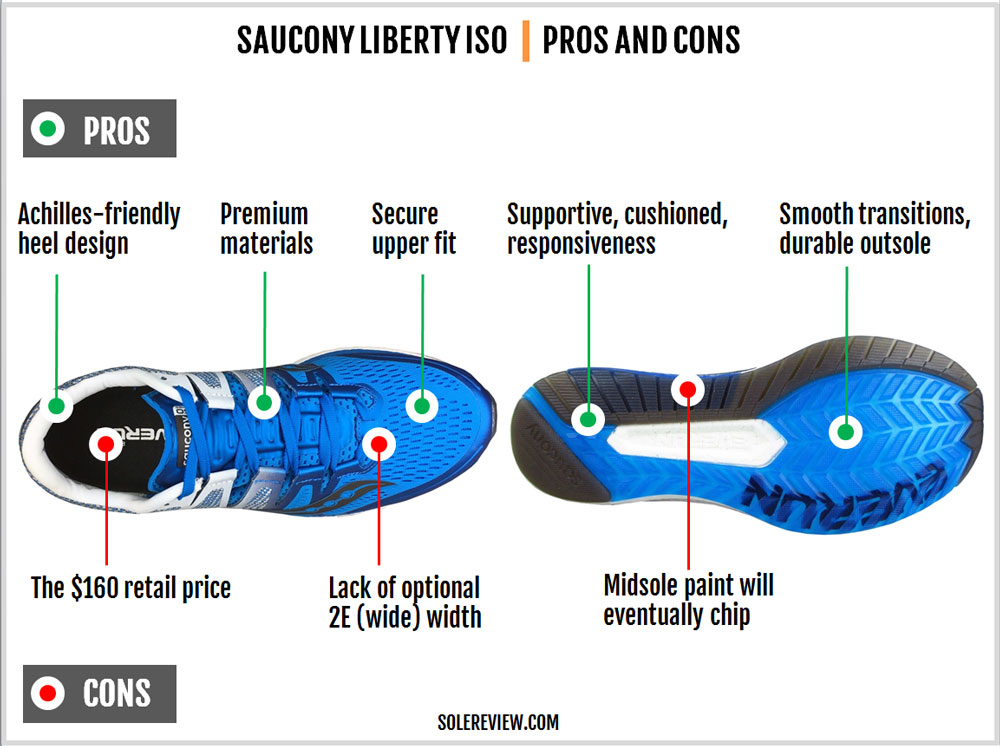INTRODUCTION
The words ‘Freedom’ and ‘Liberty’ are synonymous. Likewise, the namesake shoes also happen to be very similar. Last year, Saucony introduced the $160 Freedom ISO – a 4 mm drop trainer with a full-length Everun midsole.
It was the first Saucony shoe with a midsole made entirely of Everun, a material which uses expanded polyurethane globules fused together. Everun’s composition is identical to the adidas Boost foam, except that Saucony’s version is firmer.
The Freedom is an extremely versatile shoe suited for use-cases ranging from daily training runs, fast-paced workouts, and to the occasional marathon. The sleeved upper has a snug fit.
There are a lot of similarities between the Freedom and Liberty, be it the ride quality or the upper fit. Where the Liberty differs is its level of support. The inner midsole has a plastic stabilizer and the upper has more structure than the Freedom. The Liberty is marginally heavier as well.
For those who already own a pair of the Freedom ISO – is it worth buying the Liberty too? Considering that this is a $160 question, we say no. The Freedom/Liberty pairing isn’t quite the same as the adidas Boston/Tempo combination because the two Saucony models are fairly close in overall character.
A Liberty ISO purchase only makes sense if you want the goodness of the Freedom but crave a midsole with some medial side support.
Runners who usually stick to neutral shoes can also buy the Liberty ISO instead of the Freedom. This is because the Liberty’s support aspect is very mild and the ride experience is almost neutral.
DESIGN AND MATERIALS
The Liberty has an upper form factor similar to the Freedom. The forefoot has an engineered mesh with a fused toe-bumper, and the midfoot forms a part of the lacing mechanism. The upper splits into speed-lacing loops and hooks up with the flat laces.
Saucony calls this design ISOFIT, and this construction includes an inner sleeve which wraps around the midfoot. Okay, it’s not a full sleeve but a very wide gusset which attaches the tongue to the inside.
The tongue is borrowed from the Freedom. The top has a molded piece of foam-filled synthetic fused over, and the flap edges are interlocked with a soft thread. The tongue is slightly short, a factor which is noticed once you use the last row of heel-lock lacing.
There isn’t a lot of foam padding inside the heel collar. There’s just enough quilting to make it comfortable and grip well. The outer heel has an external support frame which is flexible.
In case you’re wondering, the Liberty ISO’s heel is collapsible.We get asked about running shoes with flexible heels a lot, so know that Liberty ISO is one of your options.
There are a couple of reflective bits on the Liberty ISO’s upper. The first one is placed behind the Achilles area on the heel, and the second bit is fused on the tongue.
So how does the Liberty’s upper differ from the Freedom? If you start from the front, you’ll see that toe-bumper is slightly higher. It is also made of a thicker material with molded details.
The midfoot panels are reinforced with a thin layer of synthetic, something which the Freedom ISO doesn’t have. The upper also uses two different kinds of mesh. The forefoot has engineered mesh while the rest of the upper has a closed textile with a patterned design.
Compared to the Freedom, the heel ‘support frame’ is larger, wrapping around the top and bottom sections of the outer heel.
These additional bits (along with the midsole stabilizer) increases the Liberty ISO’s weight by 17 grams/0.7 ounces over the Freedom.
Like the Freedom, the Liberty ISO’s midsole uses full-length Everun sans any EVA foam components. Saucony’s Everun formula is similar to the adidas Boost.
Both these platforms utilize a construction which involves fusing together a colony of expanded Polyurethane beads. (Related read: What’s inside the adidas Speedfactory?). Saucony’s version differs from the Boost in two ways.
To begin with, Everun is noticeably firmer than Boost. Ok, if we had to put a number to it, then the Everun is around 30% firmer. Saucony also molds the sidewalls differently than adidas. In Liberty ISO’s case, the midsole has waffle-shaped patterns imprinted on its side.
Secondly, the individual Everun foam globules used are smaller, thus creating a (more) densely packed structure than the Boost.
EVA (Ethylene Vinyl Acetate) foam is only used to make the removable insole. There is no foam lasting because there is another layer of Everun in the form of a Topsole.
By the way, the insoles used in the newer Saucony models are thinner. This change has been done to accommodate the Everun topsole located below the insole.
The hard plastic support piece glued on the inner midsole is the key difference between the Liberty and the Freedom. But this isn’t your traditional medial post. Rather, it is a hard piece of plastic which rises up from the outsole edge and placed flush with the midsole.
The stabilizer also extends underneath the midsole and is obscured by the outsole. The outsole is made of the same translucent rubber compound which debuted on the Freedom. The outsole is single-piece and single-density from heel to toe.
DURABILITY ASSESSMENT
The Liberty is based on the Freedom ISO template, and that makes it a very durable shoe. The hard-wearing outsole rubber is exclusive to both these models, a factor which gives the Liberty added durability over traditional Saucony shoes such as the Hurricane or the Guide.
You will face zero issues with the midsole as well. The Everun foam is derived from Polyurethane, a compound which is highly resistant to fatigue or deformation. And much like adidas Boost, Everun performs extremely well under adverse climatic conditions.
The removable insole will flatten after a few months of use. It is fairly thin to begin with, so you won’t miss much anyway. There’s an Everun Topsole under it as a back-up too.
One last thing. The ‘rim’ seen on the Everun midsole is painted, so that will crack or peel after some time. Even solereview’s brand new pair came with a paint chip.
UPPER FIT AND FEEL
The Liberty’s upper has a snug, but not narrow fit. The toe-box is actually very roomy on the sides thanks to the molded toe-bumper. The toe-box isn’t very high, but not uncomfortably shallow either.
The forefoot and midfoot are form-fitting due to the combination of the external ISOFIT overlays and the inner sleeve. The midfoot panels hug and support the arch comfortably without any pressure hot-spots.
If you’re transitioning from the Freedom ISO, we highly recommend that you stick to the same size, regardless of the Liberty’s snugger forefoot fit.
We advise that you buy true-to-size when used with a thin pair of running socks. But if you’re wearing a thicker pair of winter socks, then a half up-size will suffice.
The flexible heel grips securely. However, if you intend to use the last row of heel-lock lacing, then the shortness of the tongue will be noticed. Saucony should have made the tongue slightly longer.
Barring the short tongue, the Liberty’s upper fits great. The interiors have a seamless and smooth feel while providing a secure grip during fast turns.
RIDE QUALITY AND BEHAVIOR
The Liberty ISO’s ride quality is an excellent sweet-spot between cushioned and firm. At no point during the run that you feel that the midsole is mushy, regardless of the full-length Everun and the Topsole. A couple of factors help the Liberty (and the Freedom) achieve this delicate balance.
The Everun compound has a firm molding which prevents aggressive compression or lean. The outsole plays a role too. Unlike many Saucony shoes which use a softer blown rubber under the forefoot, both the Liberty and the Freedom ISO use hard rubber throughout.
In certain aspects, the Liberty ISO feels a bit like the adidas Boston (with its hard outsole) except that it’s more consistent due to its single-density midsole. The lack of outsole flex grooves further augments the ride firmness.
The Liberty ISO has a very responsive ride. The Everun gives a nice spring-back feedback without going overboard.
And what of the plastic stabilizer attached to the inner midsole? You don’t notice it at all. Unlike a traditional medial post, the stabilizer rises from the outsole edge and then leaves a small margin of midsole foam near the top.
So your arch never feels the sensation of a hard material underneath. The stabilizer does add support, just not the one you feel. So even if you’re always stuck to ‘neutral shoes,’ buy the Liberty ISO without fear.
The combination of the densely packed cushioning and the tinge of firmness imparts the Liberty ISO with extreme versatility. There is enough cushioning for longer runs like a marathon. On the other hand, the ride firmness and the snug upper makes the Liberty suitable for fast training runs.
The ride is also very consistent, helped by the full-length Everun and the single sheet of outsole. The forefoot isn’t super flexible and the outsole grips well, and these factors make the transitions quick.
Perhaps the only thing a runner requires is an acclimatization to the Liberty 4’s mm heel drop. This is relevant for those who have always run in shoes with an 8+ mm or higher drop (like the adidas Boston, Tempo, or the Asics DS Trainer).
If you’ve never worn a low drop shoe before, then a temporary soreness might be felt after the first couple of runs in the Liberty.
PROS AND CONS
The Liberty ISO has a long list of positives. The upper has a conforming yet comfortable fit, and the ride is consistent along with plenty of cushioning and responsiveness. The hard rubber outsole is durable and grips well.
Versatility is the Liberty ISO’s forte. The just-right ride and fit character allow the shoe to be used for a wide variety of runs.
Given the Everun’s composition (e-TPU), the midsole will maintain its cushioning properties over the life of the shoe along with superior resistance to weather.
On the flip side, we feel that both the Liberty and the Freedom are overpriced at $160. Comparable shoes from adidas cost far less, and even Saucony’s Triumph ISO 4 with its higher volume Everun midsole offers more at the same price. The Liberty also lacks optional widths, which is another area of potential improvement.
Lastly, the midsole paint will chip over time. Solereview’s brand-new pair of Liberty ISO came pre-packaged with a paint chip. (See white chipped area on blue in the picture above) This will not adversely affect the shoe’s performance, but still.
RECOMMENDED ROTATION
The Hurricane ISO 3 is a proper support shoe, medial-post and all that. It doesn’t have a full-length Everun midsole – yet. Instead, it uses an Everun heel plug inside an EVA foam casing. The upper has a plusher and more spacious interior than the Liberty ISO.
By the way, the Hurricane ISO 4 with a full-length Everun midsole will be released shortly for a princely sum of $165.
For faster runs or races, the lightweight Saucony Fastwitch 8 is an excellent choice. The New Balance 1500 V3 does the same thing.
The adidas Supernova ST combines an extremely cushioned ride with a medial-support feature not dissimilar to the Liberty. A small plastic piece on the inside adds a bit of firmness without interfering with the overall ride quality. The Supernova rides softer than both the Saucony Liberty and the Hurricane.
SIMILAR LIGHTWEIGHT SUPPORT SHOES
You don’t have to look far for shoes which are similar to the Liberty. There are two 4 mm drop models from Saucony, namely the Freedom and the Kinvara. The Freedom is almost the same shoe except for the midsole plastic. The Kinvara is a lighter running shoe with a flatter ride.
The adidas duo of the Boston 6 and the Tempo 9 use Boost, a material similar to the Everun. The Boston has a neutral ride while the Tempo’s medial-support gives it a restrained (and firmer) ride character. Considering the Liberty ISO’s mild support character, both these adidas shoes are comparable.
Lastly, Asics sells its lightweight DS-Trainer with an updated Flytefoam midsole. The Mizuno Catalyst 2 does what it does best – delivering a supportive and neutral ride experience by using its Wave plate technology.

